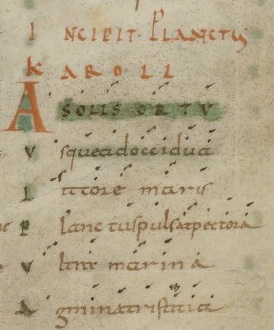Epic poetry from the time of Charlemagne has been performed and recorded by Ligeriana
Ligeriana is a vocal and instrumental ensemble under the direction of Katia Caré. It was founded in 2000. In 2013 they recorded a collection of poetic works from the 9th and 10th centuries. The epic poetry featuring in this recording was written in Latin, but did not belong to the liturgy proper. Instead these poems were part of the general musical entertainment, which it is believed was performed in the palaces of the rich and mighty. Libraries belonging to 9th century aristocrats testify that they did accommodate secular works next to the hymn-books, they needed for the chapel in their palaces and that they were particularly interested in three genres: love songs, elegies and funeral lamentations. It was this genre, which later inspired the Carmen Heroicum, in which the epic and heroic deeds lived on in the vernacular like e.g. the Chanson de Geste.
The pieces selected for this recording recall and dramatize events connected with the Carolingian Empire: the lamentation upon the death of Charlemagne, the battle of Fontenay-en-Puisaye, the ransacking of the abbey of Saint-Florent and the Emperor’s passion for the poets of Roman antiquity: Boethius, Horace, Virgil.
The most famous of these poems is the Planctus Karoli, which has survived in a manuscript in the Bibliotéque Nationale Francaise (Paris, BnF lat. 1154 (IXth c., Limoges, Saint-Martial), au f. 132r- 133v ).
This planctus was written by an anonymous monk from the abbey of Saint-Columbanus in Bobbio in Northern Italy (by some identified by Columbanus of St. Trond). It is believed that it was written shortly after the death of Charlemagne. It consists of twenty three-line strophes with a refrain: Heu mihi misero! (Alas for me in my misery). Its first line (a solis ortu usque ad occidua) was probably copied from a fifth-century hymn. Due to its rhythm and the presence of a musical notation written in 10th century neumes in BnF lat. 1154, it is generally believed that the piece was early on meant to be performed.
There are of course precious few traces left of this repertoire, which testifies to the taste of imperial courts for poetry and the arts. However, the pieces recorded in this anthology are among the very few that have kept their musical notation, a set of neumes written above the words, making a historical performance possible . The restitution of the music has involved extensive work of research and imagination in order to offer a plausible version of these jewels of the “Carolingian Renaissance”.
Carmina Carolingiana : chants épiques au temps de Charlemagne, Ligériana, Ligia Digital, 2013.
L’ensemble Ligeriana (DR)
Collection: LIGIA DIGITAL
upc/ean. 3487549902519
Release Date: 12/02/2013
HEAR MORE:
The recording of The Planctus Karoli and the other poems in the collection has been made available at YouTube
Another recording Frankish music – Planctus de Obitu Karoli (814 AD)
At the upcoming celebration at King’s College in London on the 28th of January the Planctus will be sung as it might have been heard in Charlemagne’s day, by members of the King’s College London choir.
READ MORE:
Planctus Karoli
Paris, BnF lat. 1154 (IXth c., Limoges, Saint-Martial), au f. 132r- 133v.
The standard Latin edition of the poem may be found in Ernst Dümmler, ed. (1881), Poetae latini aevi Caroli, MGH, I (Berlin), 434–436.
A translation may be found in Peter Godman (1985), Latin Poetry of the Carolingian Renaissance (Norman: University of Oklahoma Press), 206–211.
Sam Barrett (1997), Music and Writing: On the Compilation of Paris Bibliotheque Nationale lat. 1154, Early Music History, 16, 62, classifies the Planctus among the political works of the manuscript. The article discusses the very early neumes and how to understand them.
